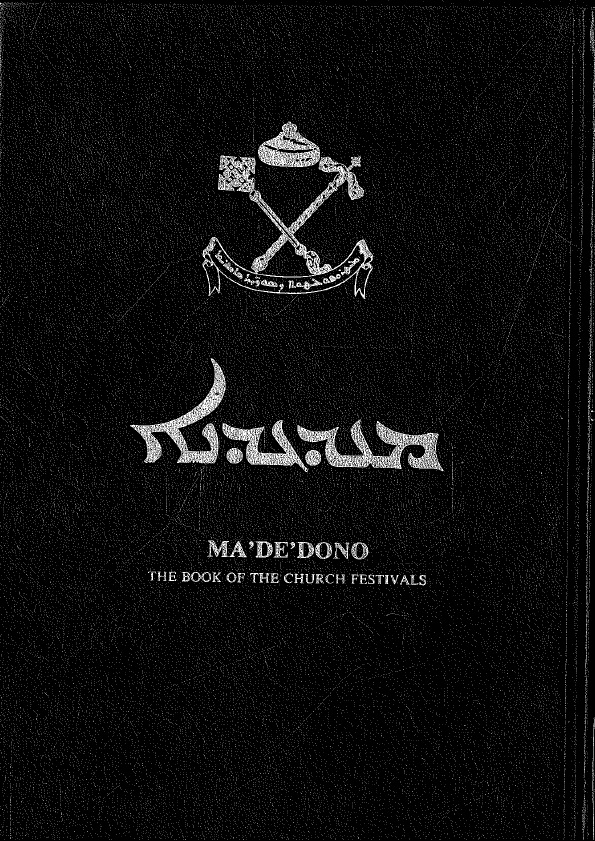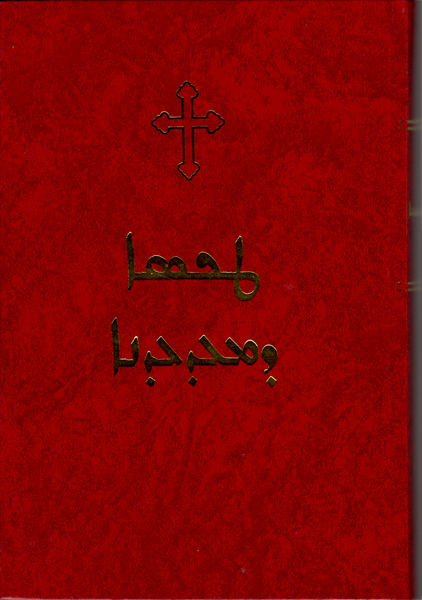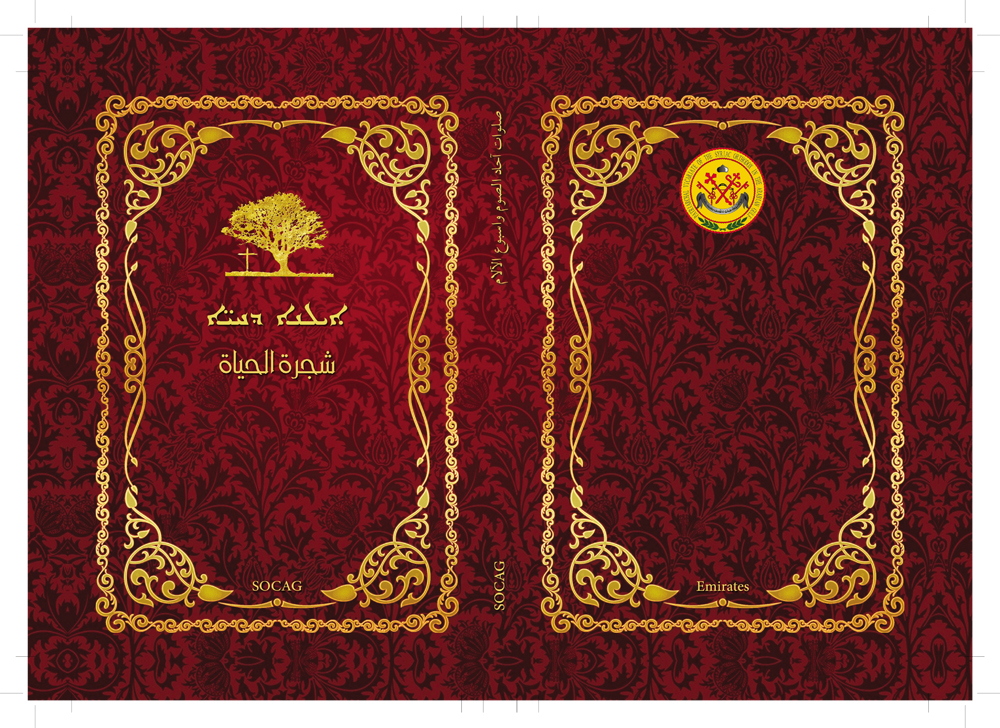كتاب رتب الاعياد الكنسية (ܡܥܰܕܥܕܳܢܳܐ)
طقس الأعياد الحافلة “المعدعدان”، بحسب تقليد كنيسة أنطاكية السريانية الأرثوذكسية. ضبطه وحرّره على النسخ السريانية القديمة والصحيحة ونقل بعض نصوصه إلى اللغة العربية واختصره ونشره بأصله السرياني مع ترجمته اغناطيوس يعقوب الثالث، مطابع الكريم الحديثة، جونية، سنة 1978.
ܥܐܕܐ ܕܝܠܕܐ ܦܪܘܩܝܐ – طقس عيد ميلاد المخلص المقدس
ܕܢܚܐ ܐܠܗܝܐ – طقس تبريك الماء يوم عيد الظهور الإلهي
ܒܘܪܟ ܩܪ̈ܝܘܢܐ – طقس تبريك الشموع
ܫܘܒܩܢܐ ܕܨܘܡܐ ܐܪܒܥܝܢܝܐ – طقس المسامحة الذي يُمارَس يوم الاثنين مدخل الصوم الكبير المقدّس
ܙܘܝܚ ܨܠܝܒܐ ܦܪܘܩܝܐ (ܦܠܓܗ ܕܨܘܡܐ) – طقس زياح الصليب الذي يُمارس يوم الأربعاء منتصف الصوم الأربعيني
ܒܘܪܟ ܣܘ̈ܟܐ (ܐܘ̈ܫܥܢܐ) – طقس تبريك الأغصان – الشعانين
ܘܥܕܗ ܕܠܡܐܢܐ (ܢܗܝܪ̈ܐ) – طقس دورة النهيرة
ܫܝܓܬܐ ܐܪܙܢܝܬܐ – طقس الغسل السري
ܣܓܕܬܐ ܕܨܠܝܒܐ ܒܝܽܘܡ ܥܪܽܘܒܬܳܐ ܕܰܙܩܺܝܦܽܘܬܳܐ – طقس سجدة الصليب في جمعة الصلبوت
ܫܘܒܩܢܐ ܕܫܒܬܐ ܕܣܒܪܬܐ– طقس المسامحة الذي يُمارس يوم سبت البشارة
ܚܕ ܒܫܒܐ ܕܩܝܡܬܐ – طقس زياح أحد القيامة العظيم
ܛܟܣܐ ܕܫܠܡܐ – طقس السلام الخاص بأحد القيامة العظيم
ܦܢܛܝܩܘܣܛܝ – طقس السجدة الذي يُمارس يوم أحد العنصرة
طقس الأعياد الحافلة “المعدعدان”، بحسب تقليد كنيسة أنطاكية السريانية الأرثوذكسية. PowerPoint إعداد الراهبة سيدة الياس من راهبات دير مار يعقوب البرادعي
ܥܐܕܐ ܕܝܠܕܐ ܦܪܘܩܝܐ – طقس عيد ميلاد المخلص المقدس
ܕܢܚܐ ܐܠܗܝܐ – طقس تبريك الماء يوم عيد الظهور الإلهي
ܒܘܪܟ ܩܪ̈ܝܘܢܐ – طقس تبريك الشموع
ܫܘܒܩܢܐ ܕܨܘܡܐ ܐܪܒܥܝܢܝܐ – طقس المسامحة الذي يُمارَس يوم الاثنين مدخل الصوم الكبير المقدّس
ܙܘܝܚ ܨܠܝܒܐ ܦܪܘܩܝܐ (ܦܠܓܗ ܕܨܘܡܐ) – طقس زياح الصليب الذي يُمارس يوم الأربعاء منتصف الصوم الأربعيني
ܒܘܪܟ ܣܘ̈ܟܐ (ܐܘ̈ܫܥܢܐ)– طقس تبريك الأغصان – الشعانين
ܘܥܕܗ ܕܠܡܐܢܐ (ܢܗܝܪ̈ܐ) – طقس دورة النهيرة
ܫܝܓܬܐ ܐܪܙܢܝܬܐ – طقس الغسل السري
ܣܓܕܬܐ ܕܨܠܝܒܐ ܒܛܗܪܐ – طقس سجدة الصليب في جمعة الصلبوت ظهراً
ܣܓܕܬܐ ܕܨܠܝܒܐ – طقس سجدة الصليب في جمعة الصلبوت
ܫܘܒܩܢܐ ܕܫܒܬܐ ܕܣܒܪܬܐ – طقس المسامحة الذي يُمارس يوم سبت البشارة
ܚܕ ܒܫܒܐ ܕܩܝܡܬܐ – طقس زياح أحد القيامة العظيم
ܛܟܣܐ ܕܫܠܡܐ – طقس السلام الخاص بأحد القيامة العظيم
ܣܽܘܠܳܩܶܗ ܕܡܳܪܰܢ ܠܰܫܡܰܝܳܐ – عيد الصعود , زياح الصليب
ܡܥܕܥܕܢܐ(ܣܘܪܝܝܐ – ܐܢܓܠܝܫܝܐ)
ܡܥܕܥܕܢܐ (ܣܘܪܝܝܐ – ܥܪܒܝܐ ܓܪܫܘܢܝ)
سرياني – گرشوني
طقس الأعياد الحافلة المعدعدان نقله ونظمه قداسة مار اغناطيوس يعقوب الثالث 1978
Service Book for Principal Feasts
The Syrians have a special service book for principal feasts called the M‘adh‘dhono. It contains the Orders for the Nativity of our Lord, the Order for the consecration of water on the Epiphany, the Order for the Monday of Lent called the Monday of Forgiveness, the Order for the mid-Lent Festival of the Cross, the Order for the Consecration of Branches on Palm Sunday, the Festival of Lights or the Night of Entrance into the Heavenly Chamber, the Order for the Washing of Feet on the Thursday of Passion Week, the Burial Service of the Cross on Good Friday,[1] the Order for Peace on Easter morning, the Order for the Adoration of the Cross on Pentecost and the Order for the Benediction of the Cross.
The Eastern rite contains hymns chanted in the festivals commemorating Simon the Aged and the Presentation of our Lord in the Temple. The Beth Gazo of the ‘Ayn Ward, written in 1468, mentions the Benediction of the Cross according to the custom of the Church of the Forty Martyrs in Mardin. Also, the service book of the principal feasts of the Monastery of Mar Eugene contains the Benediction of the Cross used in the festivals of the Virgin and the saints.
The Beth Gazo of the Jerusalem Library (MS. 62, dated 1569), mentions that the order for the consecration of water (on Epiphany day) was written by Severus, Patriarch of Antioch, but revised and vocalized by Jacob of Edessa. According to Jacob of Edessa, the first prayer for the consecration of water in the festival of Epiphany, beginning “Great art thou, O Lord and wonderful are thy works,” was composed by Proclus, bishop of a diocese of Cyprus. And when St. Epiphanius, metropolitan of Cyprus, read this prayer in 404, he admired it and expanded it. This prayer exists in the Byzantine rite because its author, St. Proclus, lived in the middle of the fourth century, not in the seventh, as Lucian has erroneously stated in his book, The Christian Orient. Although the old British Museum MS. 14494, written on vellum, mentions that the author of the consecration of water on the Epiphany was Proclus of Constantinople (d. 444), yet the testimony here about Jacob of Edessa is more thorough and accurate.[2]
In his comment on the service book of principal feasts in Bartelli, on January 30, 1282, Bar Hebraeus states that in the Eastern rite the deacon recites, at the consecration of water, the prayer for the descent of the Holv Ghost. He was annoyed and for eighteen years kept patient, until the clergy convinced of their error, agreed to follow the Western rite in this case.[3]
In an old copy (of this service book) in the handwriting of deacon David Joseph the Egyptian, dated 1403, we are informed that Sa’id Bar Sabuni, metropolitan of Melitene, compiled an Order for the consecration of Branches on Palm Sunday and that he corrected and vocalized the Order of the Adoration of the Pentecost.[4]
What should be noted here is that the traditions and customs of performing the rituals and prayers differed in the countries of the Syrians. The practiced customs were called traditions or perhaps better still “Orders.” The most important of these were the Order of Edessa, the Order of the Monastery of Qenneshrin, the Order of Melitene, the Order of the Monastery of Mar Barsoum and the Order of the East practised in Takrit and Mosul, the Order of Mardin and the Monastery of Mar Hananya, the order of Amid, the order of the Monastery of Qartmin, the order of Tur ‘Abdin, the order of Mesopotamia, the order of the upper Jazira situated on the river Khabur. Also, the Monastery of Mar Abhai, the Monastery of Notfo were sometimes in this regard added to the Monastery of Mar Hananya.
In his comment on the Eastern Rite or Order mentioned once before, Bar Hebraeus states that during his occupation of the See of Takrit he discovered many differences between the Eastern and the Western orders. But he found in the arrangement of the Eastern Order with its diverse forms and divisions an arresting beauty which made him admit to the excellence of its authors. He only criticized the specific prayer for the benediction of the water in the Feast of the Epiphany mentioned before.
In order to give an idea of the orders of the principal feasts as well as of the different traditions used in performing the rituals, we should quote the Beth Gazo compiled by Simon, metropolitan of ‘Ayn Ward as an illustration:
“To begin with, we have the Order of the Nativity according to the tradition of the Church of the Fort)’ Martyrs in Mardin; the Order of Epiphany revised by Jacob of Edessa and preceded by an explanatory note by George, bishop of the Arabs, and followed by a commentary by Bar Hebraeus. (This order has been arranged according to the tradition of the Monastery of Mar Barsoum, the Monastery of Mar Hananya and the Monastery of Notfo (Strangers) as copied from the manuscript of Rabban Ṣaliba Khayrun [al-Shaykh] in 1340 which in turn was transcribed from the copy of Patriarch Michael the Great). Then, the Order of the Presentation of Our Lord in the Temple according to the tradition of Mardin; the Order of Forgiveness for the Lent; a second order according to the tradition of Mardin; the Order of the Consecration of Branches transcribed from the copy of Rabban Saliba from the copy of Patriarch Michael the Great; the Order of Lights according to the Edessan tradition; the celebration of the Divine Eucharist on Christmas eve as well as on the evening of Thursday of the Passion Week; the Order of Good Friday (the Crucifixion) according to the tradition of the Church of the Forty Martyrs in Mardin; a second Order according to the tradition of the Monastery of St. Gabriel in Tur ‘Abdin; the Order of Easter according to the traditions of the Monasteries of Mar Barsoum and Mar Hananya, another order for Easter according to the beautiful established tradition of the Monastery of St. Gabriel.”
Simon of ‘Ayn Ward also alluded to an Eastern ritualistic tradition in the festival of the Ascension according to which the deacon lifts up the paten and the priest the cup during the final elevation of the Mysteries. The custom is still used in Mosul and all of Iraq until this day.
Source: Barsoum, Ignatius Aphram. The Scattered Pearls: A History of Syriac Literature and Sciences. Translated by Matti Moosa. 2nd revised. Piscataway, New Jersey: Gorgias Press, 2003, 87-90.
[1] The order of forgiveness occurs on the Saturday of Annunciation, according to the service book transcribed by the Patriarch Basilius in 1443. See manuscript 23 of the Jerusalem Libran’ and the M‘adh‘dhono (Service Book of Feasts) transcribed by the Monk Malke Saqu in 1484 in the Monastery of Mar Eugene which ends with a homily on love given by the bishop.
[2] Fol. 16a of MS. 14494 mentions the order for the consecration of water on the Epiphany, but does not give the name of any author. See W. Wright, Catalogue of Syrian Manuscripts, 1: 217. (tr.)
[3] See the Service Book of Feasts in the Za’faran Library MS. 212, called M‘adh‘dhono in Syriac and Hirmologion in Greek. There are two copies of this book according to the Byzantine rite in the Library of Mount Sinai, one of them (MS. 40) written on vellum and the other one (MS. 64) on paper dated 1255.
[4] 2 Preserved at the Syrian Church in Cairo.



